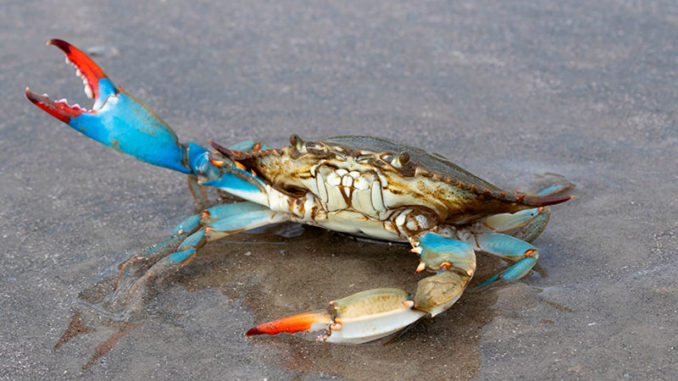
Blue crabs (Callinectes sapidus) are one of the most highly sought after shellfish throughout their range. They are easy to find, easy to catch, and are great for eating or to use as bait for a variety of fish.
They are among the most valuable saltwater species among commercial as well as recreational anglers.
Blue crabs are common up and down the Atlantic coast and the Gulf of Mexico. The shell, which is called the “carapace,” is a blue to olive green color, and can measure as much as 9 inches across. The claws are often bright blue, and mature female blue crabs have red tips on their claws.
These crabs use three pairs of walking legs and rear swimming legs that resemble paddles. It’s easy to distinguish male from female blue crabs by looking at their abdomens, which are also called “aprons.” A male’s apron has what appears to be a long, thin rocket. It’s often compared to the Washington Monument. Females have a wide apron, which resembles the dome of the U.S. capitol building.
Blue crabs become mature anywhere from 12 to 18 months. Their growth rate is determined by the water temperature, with warmer water helping them mature more quickly.
As they grow, blue crabs go through a molting phase, where they shed their shell before developing a new one. Males molt numerous times throughout their lives. Females molt just once, right before they are ready to mate.
Not picky eaters
Their diet is full of variety. They will eat almost anything. Clams, oysters, mussels, smaller crabs, shellfish, dead fish, and numerous plants and animal debris make up the bulk of their meals.
Blue crabs are eaten by many different species of fish. If it’s big enough to eat a blue crab, just about any fish will. Fish-eating birds like blue herons also gobble up blue crabs when given the chance. Sea turtles also enjoy a blue crab meal. In brackish waters, blue catfish will do the same.
The claws of a blue crab are extremely powerful, and used to gather food, as well as to defend against predators. Blue crabs also use them to dig and to alert other wildlife to their presence. They can inflict serious pain on anglers who do not handle them properly.
Anglers often cut blue crabs into quarters to use as bait. Redfish especially find these offerings to be quite delicious.


